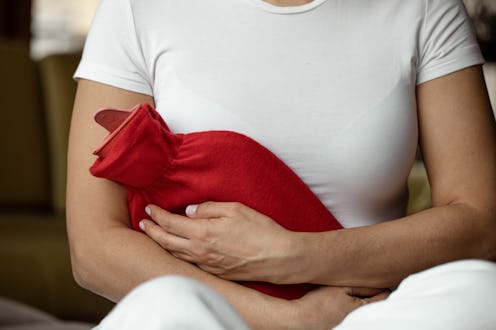Health
OB-GYNs Explain What A Decidual Cast Is
Today in “things I didn’t know my body could do.”

Periods are bizarre when you stop to think about them: once a month, your body spontaneously throws out its own uterine lining in a fit of spring-cleaning. For some people, however, that removal can take a more unusual form: a decidual cast, which is when your uterine lining comes out all in one piece. This might sound like something out of a horror movie, but experts tell Bustle that while decidual casts are very rare, they're not necessarily a sign of anything troublesome.
To understand what a decidual cast is, Dr. Lisa Valle M.D, an OB-GYN at Providence Saint John's Health Center, tells Bustle, you need to know what a decidua is. "Decidua describes when the lining of the uterus undergoes changes from the influence of progesterone in preparation for pregnancy during the secretory phase of the menstrual cycle," Dr. Valle says. "A decidual cast occurs when this entire lining is sloughed off and comes out in one large piece resembling the shape of the uterine cavity."
This is actually very unusual. As people with periods know, usually period blood is quite a bit more, well, liquid. "When the lining of the uterus sheds and passes from the uterus and into the vagina and then all the way out, the lining usually falls apart into many pieces or even sloughs off the inside of the uterus at slightly different times, rather than staying intact, in one larger piece, and passing all at the same time," Dr. Karen Duncan, M.D., assistant professor in the Department of Obstetrics and Gynecology at NYU Langone Health, tells Bustle.
The decidual cast itself is essentially a perfect replica of the inside of your uterus — because that's what it is. "A decidual cast usually looks pretty wild," Dr. Duncan says. "It's really just a combination of the tissue that was lining the uterus along with some blood and mucous — just all in one larger piece."
Decidual casts have varied causes. "Rarely, casts can occur with oral contraceptive pills or Depo-Provera," says Dr. Valle. They can also be a sign of an ectopic pregnancy, a condition in which a fertilized egg implants itself somewhere outside the uterus, like in the fallopian tubes. Ectopic pregnancies can be pretty serious, but they're relatively rare; they only account for 2% of all reported pregnancies, according to the American College of Obstetricians & Gynecologists.
Decidual casts, however, are extremely rare. "They are not commonly mentioned in OB-GYN textbooks and are mostly described in rare case studies in scientific literature," Dr. Duncan tells Bustle. "Passing a decidual cast does not necessarily indicate an urgent problem, but when a woman passes a cast, she may have a significant amount of discomfort and cramping pain (like pretty bad menstrual cramps)." That's not a signal that you're in trouble; large cramps are required for the body to pass the whole cast at once.
If you do discover that you've produced a cast, you shouldn't panic — but you should see an expert. "Anytime a women has severe or worsening pain with periods, or passes anything strange looking from the vagina, I definitely recommend seeing your OB-GYN," Dr. Duncan says. This is particularly the case if you think you may have the signs of an ectopic pregnancy, including serious abdominal pain, strange bleeding patterns and, in the case of a fallopian tube rupturing, sudden intense pain. No other symptoms? It's likely just an interesting, rare side effect — though you probably shouldn't put pictures on Instagram.
Experts:
Dr. Karen Duncan M.D.
Dr. Lisa Valle M.D.
Studies cited:
Mori, M., Bogdan, A., Balassa, T., Csabai, T., & Szekeres-Bartho, J. (2016). The decidua-the maternal bed embracing the embryo-maintains the pregnancy. Seminars in immunopathology, 38(6), 635–649. https://doi.org/10.1007/s00281-016-0574-0
Stoelting-Gettelfinger W. (2010). A case study and comprehensive differential diagnosis and care plan for the three Ds of women's health: primary dysmenorrhea, secondary dysmenorrhea, and dyspareunia. Journal of the American Academy of Nurse Practitioners, 22(10), 513–522. https://doi.org/10.1111/j.1745-7599.2010.00544.x
This article was originally published on